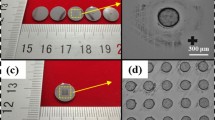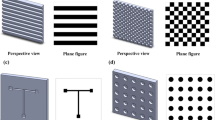Abstract
Hot embossing is a low-cost processing approach for polymer-based microfabrication. However, the time and cost are two major problems in the mold industry to produce a precision hot embossing mold with high surface finish for the pilot run in the new product development phase. This study investigates the optimum process parameters of plasma surface modification to fabricate a precision micro-hot-embossing mold without the use of release agent. The first silicone rubber mold with the lowest surface roughness can be utilized for fabricating a precision hot embossing mold using rapid tooling technology. It was found that the dominant factor affecting the surface roughness of the first silicone rubber mold is the plasma-arc distance. The optimum process parameters to fabricate a hot embossing mold with high surface finish are plasma power of 70 W, treatment time of 3 min, gas flow rate of 25 sccm, and plasma-arc distance of 40 mm. The replication rates for depth and width of the fabricated Al-filled epoxy resin mold about 92.4 and 98.1% can be obtained using the optimum process parameters. The improvement rate of the surface roughness of the fabricated Al-filled epoxy resin mold about 39.4% can be reached.
Similar content being viewed by others
References
Park IB, Ha YM, Lee SH (2010) Cross-section segmentation for improving the shape accuracy of microstructure array in projection microstereolithography. Int J Adv Manuf Technol 46(1):151–161
Thian SCH, Fuh JYH, Wong YS, Loh HT, Gian PW, Tang Y (2008) Fabrication of microfluidic channel utilizing silicone rubber with vacuum casting. Microsyst Technol 14:1125–1135
Kuo CC, Lin ZY (2011) Development of bridge tooling for fabricating mold inserts of aspheric optical lens. Mater Werkst 42:1019–1024
Zhang J, Sahli M, Gelin JC, Barriere T (2015) Rapid replication of metal microstructures using micro-powder hot embossing process. Int J Adv Manuf Technol 77(9):2135–2149
Kuo CC, Hsu HJ (2013) Development and application of hybrid mold with microfeatures in micro-hot embossing. Mater Manuf Process 28(11):1203–1208
Kuo CC (2013) Development of green rapid tooling technologies. Indian J Eng Mater Sci 20(4):245–251
Kuo CC, Lin ZY (2012) Rapid manufacturing of plastic aspheric optical lens. Mater Werkst 43:495–502
Kuo CC (2012) A simple and cost-effective method for fabricating epoxy-based composites mold inserts. Mater Manuf Process 27:383–388
Kim JH, Kousaka H, Umehara N, Shimada M, Hasegawa M (2012) Surface modification of surface wave-excited plasma-treated chloride-isobutene rubber for adhesion reduction. Mater Manuf Process 27:1257–1261
Kumruoğlu LC, Ozel A (2010) Surface modification of AISI 4140 steel using electrolytic plasma thermocyclic treatment. Mater Manuf Process 25:923–931
Guo L, Liu X, Gao J, Yang J, Guo T, Zhu Y (2010) Effect of surface modifications on the bonding strength of titanium–porcelain. Mater Manuf Process 25:710–717
Kim YW (2010) Surface modification of Ti dental implants by grit-blasting and micro-arc oxidation. Mater Manuf Process 25:307–310
Kumruoglu LC, Becerik DA, Ozel A, Mimaroglu A (2009) Surface modification of medium carbon steel by using electrolytic plasma thermocyclic treatment. Mater Manuf Process 24:781–785
Arrighi S, Borgia V (2009) Surface modifications of flint tools and their functional meaning. Mater Manuf Process 24:922–927
Kuo CC, Wang YJ (2014) Development of a micro-hot embossing mold with high replication fidelity using surface modification. Mater Manuf Process 29(9):1101–1110
Morent R, Geyter ND, Leys C (2008) Effects of operating parameters on plasma-induced PET surface treatment. Nucl Inst Methods Phys Res B 266:3081–3085
Sartori S, Rechichi A, Vozzi G, Acunto MD, Heine E, Giusti P, Ciardelli G (2008) Surface modification of a synthetic polyurethane by plasma glow discharge: preparation and characterization of bioactive monolayers. React Funct Polym 68:809–821
Wang CX, Qiu YP (2007) Two sided modification of wool fabrics by atmospheric pressure plasma jet: influence of processing parameters on plasma penetration. Surf Coat Technol 201:6273–6277
Sarikaya O (2005) Effect of some parameters on microstructure and hardness of alumina coatings prepared by the air plasma spraying process. Surf Coat Technol 190:388–393
Noeske M, Degenhardt J, Strudthoff S, Lommatzsch U (2004) Plasma jet treatment of five polymers at atmospheric pressure: surface modifications and the relevance for adhesion. Int J Adhes Adhes 24:171–177
Lin YC, Hocheng H, Fang WL, Chen R (2006) Fabrication and fatigue testing of an electrostatically driven microcantilever beam. Mater Manuf Process 21:75–80
Zhang X, Qu N, Li H, Xu Z (2015) Investigation of machining accuracy of micro-dimples fabricated by modified microscale pattern transfer without photolithography of substrates. Int J Adv Manuf Technol 81(Issue 9):1475–1485
Wentai S, Zhidong L, Mingbong Q, Zongjun T (2016) Wire tension in high-speed wire electrical discharge machining. Int J Adv Manuf Technol 82(Issue 1):379–389
Umbrello D, Rotella G, Matsumura T, Musha Y (2015) Evaluation of microstructural changes by X-ray diffraction peak profile and focused ion beam/scanning ion microscope analysis. Int J Adv Manuf Technol 77(Issue 5):1465–1474
Xu L, Pan Y (2014) Electrochemical electrochemical micromachining using vibrating tool electrode. Int J Adv Manuf Technol 75(Issue 5):645–650
Leksakul K, Limcharoen A (2014) Central composite designs coupled with simulation techniques for optimizing RIE process. Int J Adv Manuf Technol 70(Issue 5):1219–1225
Kou Z, Wan Y, Liu Z, Cai Y, Liang X (2015) Deformation control in micro-milling of thin-walled structures. Int J Adv Manuf Technol 81(Issue 5):967–974
Fu X, Zhang Q, Gao L, Liu Q, Wang K, Zhang YW (2016) A novel micro-EDM—piezoelectric self-adaptive micro-EDM. Int J Adv Manuf Technol 85(Issue 1):817–824
Giorleo L, Ceretti E, Giardini C (2016) Optimization of laser micromachining process for biomedical device fabrication. Int J Adv Manuf Technol 82(Issue 5):901–907
Xu B, Wu XY, Ling SQ, Luo F, Du CL, Sun XQ (2013) Fabrication of 3D metal micro-mold based on femtosecond laser cutting and micro-electric resistance slip welding. Int J Adv Manuf Technol 66(Issue 5):601–609
Author information
Authors and Affiliations
Corresponding author
Rights and permissions
About this article
Cite this article
Kuo, CC., Wang, YJ. Optimization of plasma surface modification parameter for fabricating a hot embossing mold with high surface finish. Int J Adv Manuf Technol 91, 3363–3369 (2017). https://doi.org/10.1007/s00170-017-0027-5
Received:
Accepted:
Published:
Issue Date:
DOI: https://doi.org/10.1007/s00170-017-0027-5




